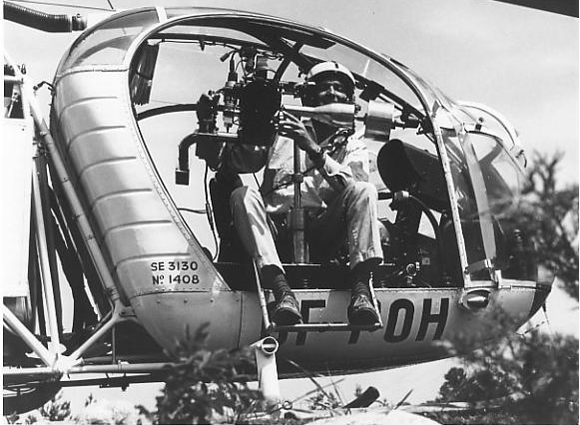Helicopter Canada
Written by Donald Brittain and Derek May
Directed by Eugene Boyko
Canada, 1968
Last November, Netflix Canada and the National Film Board extended a deal they had made earlier that year, making upwards of twenty additional NFB documentaries available for streaming. Though it’s a far cry from the 13,000+ shorts and features available on the NFB’s own website, it’s a nice gesture, a way to make this particular iteration Netflix uniquely Canadian (and a way to get the necessary CanCon into the service to make it legal). One of the films added in November was Helicopter Canada, a mid-length documentary consisting solely of helicopter shots of the Canadian landscape. The effect is often thrilling, effortlessly creating power shot after power shot of both city and country, but much of why it doesn’t work is as much structural as it is political.
Helicopter Canada was originally commissioned by the federal government as part of Canada’s centennial celebration in 1967. The idea was to celebrate the Dominion of Canada in all her glory (the film’s words, not mine) by chronicling a loose westward journey from the Atlantic to the Pacific. The film was released internationally a year later, and got an Oscar nomination for its trouble. Strictly speaking, this is a propaganda piece, extolling the virtues of both Canadian industry and citizenry, but leave it to Canada to make a self-congratulatory propaganda piece that feels hopelessly quaint. NFB lifer Stanley Jackson narrates the film in the same way your affable, dorky uncle might: lots of corny jokes and folky truisms that veer wildly between the amusing and the cringe-worthy. The film starts off on the wrong side of this divide: the first shot of the film is that of a beach packed with, as Jackson puts it, “happy Indians.” This is a canny move; it makes the film’s later casual isms sting a lot less.
Embarrassing politically-incorrect interjections aside, there are plenty of moments of abstract beauty on display here. There is a slow zoom-in on a fur trapper riding a snowmobile, where they start off as a moving black dot on a white landscape. But the film’s secret success is putting humans in scale: everyone is dwarfed by their surroundings. Still, even though the film is working on a macro level, director Eugene Boyko and company manage to capture smaller lyrical moments, like a figure skater practicing a routine, or a smoke cloud hanging in the air. It’s not as formally adventurous as, say, Koyaanisqatsi, nor does it address what it depicts beyond pointing out that it’s real pretty or important, but Helicopter Canada does successfully present the Great White North as a series of dissimilar grandiose tableaux. The sheer vastness of the country comes into sharp focus after the fourth or fifth different climate and/or geological shield appears on screen.
 The sound design gets surprisingly complex and layered at times. This is partly out of necessity: the sync-sound version of the film would have just been an hour’s worth of helicopter blades chugging. Instead, the sound designers build approximations of what the landscape’s soundtrack could be: overlapping dialogue, the sounds of motors and feet, the coo of wildlife. And yet, as impressive as the sound editing is in the film, it still insists on having a narrator/teacher figure crack dad jokes over majestic shots that practically beg to be looked at in silence, or at least scored by Stompin’ Tom Connors or the McGarrigle sisters.
The sound design gets surprisingly complex and layered at times. This is partly out of necessity: the sync-sound version of the film would have just been an hour’s worth of helicopter blades chugging. Instead, the sound designers build approximations of what the landscape’s soundtrack could be: overlapping dialogue, the sounds of motors and feet, the coo of wildlife. And yet, as impressive as the sound editing is in the film, it still insists on having a narrator/teacher figure crack dad jokes over majestic shots that practically beg to be looked at in silence, or at least scored by Stompin’ Tom Connors or the McGarrigle sisters.
As far as jingoism goes, Helicopter Canada is fairly subdued; propaganda pieces generally don’t end on notes of modesty and self-deprecation. The movie itself then is a very valuable time capsule, not only regarding what the country looked like around the time it turned 100, but what our own government thought we wanted to see about ourselves at a time when national pride was at an all-time high. In its own way, the film chronicles the end of an era; by the time the film was released, Lester Pearson was out as Prime Minister, and Pierre Trudeau was in. Helicopter Canada was the last hurrah of a very specific kind of old-hat mid-century liberal nationalism that painted Canada as a scrappy welterweight carving out its place in the world. Don’t forget, this is 1968; Canada is not yet (a) officially bilingual, (b) a G7 country, or even (c) in possession of its own constitution. As amazing as the visual of this film can be, it’s mostly must-see because they amount to flipping through baby pictures; Canada has changed and mutated into this whole other beast, but even then, this is recognizably us, lame jokes and all.


